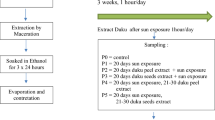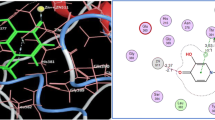Abstract
The use of mercury containing skin-lightening creams are becoming increasingly popular among dark-skinned women. The long term use of certain brands may cause serious health effects over the years. In the present study, we investigated the dermal absorption of mercury and its accumulation in the tissues of albino and pigmented mice treated with two brands of mercury containing skin-lightening creams for a period of one months at different intervals. The mean ± SD of mercury in the selected brands were: (1) Fair & Lovely (0.304 ± 0.316 μg/g); and (2) Rose (77513.0 ± 71063.0 μg/g). Mercury levels were measured in a total of 133 and 144 liver, kidney and brain tissue samples of albino and pigmented mice respectively by the Atomic Absorption Spectrophotometer coupled to Vapour Generator Accessory. In both strains, we found that the mercury concentration in the tissues of mice treated with Rose skin-lightening cream samples was significantly higher than those treated with Fair & Lovely skin lightening cream. Looking at the mercury concentration in the tissue samples with respect to the application of skin lightening creams at different intervals, the highest mercury concentrations were found in the tissues of albino and pigmented mice treated three times a day. On the other hand, the lowest mercury concentrations were found in the tissues of mice treated once a week. Despite the brand of skin-lightening cream that was applied, the study indicated that mercury was readily absorbed through the skin of both albino and pigmented mice as evidenced with its accumulation in the brain, kidney and liver tissues where the kidney had the highest mercury content and brain had the lowest (it P<0.0001). Significant differences in the mercury levels were observed between the albino and pigmented mice. This emphasizes the protective role of melanin against mercury toxicity. Results of this study stresses the potential harm of these mercury containing skin-lightening creams regardless of their mercury contents especially for women who apply these creams frequently or for extended periods. Permanent nephrological or/and neurological deficits may occur if the damage is severe and diagnosis and treatment are delayed.
Similar content being viewed by others
References
Aberer W, Gerstner G, Pehamberger H. 1990 Ammoniated mercury ointment: outdated but still in use. Cotact Dermatitis 23(3), 168-171.
Adebajo SB. 2002 An epidemiological survey of the use of cosmetic skin lightening cosmetics among traders in Lago, Nigeria. West Afr J Med 21(1), 51-55.
Afonne OJ, Orisakwe OE, Obi E, Dioka CE & Ndubuka GI. 2002 Nephrotoxic actions of low-dose mercury in mice: protection by zinc. Arch Environm Health 57(2), 98-102.
ATSDR, Agency for Toxic Substances and Disease Registry. 1992 Mercury toxicity. Am Family Physician 46(6), 1731-1741.
Al-Saleh I, El-Doush I. 1997 Mercury content in skin lightening creams and potential hazards to the health of Saudi women. J Toxicol Environ Health 51, 131-148.
Al-Saleh I, Shinwari N. 1997 Urinary mercury levels in females: Influence of skin lightening creams and dental amalgam fillings. BioMetals 10, 315-323.
Balluz LS, Philen RM, Sewell CM, Voorhees RE, Falter KH, Paschal D. 1997 Mercury toxicity associated with a beauty lotion, New Mexico. Int J Epidemiol 26, 1131-1132.
Baranowska-Dutkiewicz B. 1982 Evaluation of the skin uptake of mercuric chloride in man. J Appl Toxicol 2(5), 223-225.
Barr RD, Woodger BM, Rees PH. 1973 Levels of mercury in urine correlate with the use of skin lightening creams. Am J Clin Pathol 59, 36-40.
Barry B. 1983 Properties that influence percutaneous absorption. In: Dermatological formulations: percutaneous absorption. New York: Marcel Dekker; 127-133.
Bourgeois M, Dooms-Goossens A, Knockard D, Sprengers D, Van Boven M, Van Tittelboom M. 1986 Mercury intoxication after topical application of metallic mercury ointment. Dermatologica 172, 48-51.
Brown KG, Abrahams C, Meyers AM. 1977 The nephrotic syndrome in Malawian blacks. S Afr Med J 52(7), 275-278.
Cole HN, Schreiber N, Sollman T. 1930 Mercurial Ointment in the treatment of syphilis. Arch Dermatol 21, 372-393.
Corsaro C, Scalia M, Blanco AR, Aiello I, Sichel G. 1995 Melanins in physiological conditions protect against lipoperoxidation. A study on albino and pigmented Xenopus. Pigment Cell Res 8(5), 279-282.
Daian T, Namikoshi T, Fujii H. 1995 Intracellular distribution of Hg2+ applied to epidermis in mice. Analysis of subcellulr fraction. J Dermatol Sci 10, 233-237.
Emmett EA. 1986 Toxic responses of the skin. In: Casarett and Doull's Toxicology. The basic science of poisons. 3rd edition, Klaassen CD, Amdur MO, Doull J. New York: Macmillan Publishing Company; 463-482.
Enwonwu CO. 1987 Potential health hazard of the use of mercury in dentistry: Critical review of the literature. Environ Res 42, 257-274.
FDA, Food and Drug Administration. 1992 FDA's Cosmetics Handbook. U.S. Department of Health and Human Services, Public Health Service, Food and Drug Administration.
Friberg L, Skog E, Wahlberg JE. 1961 Resorption of mercuric chloride and methyl mercury dicyandiamide in guinea-pigs through normal skin and through skin pre-treated with acetone, alkylarysulphonate and soap. Acta dermatovenereol 41, 40-52.
Furumura M, Solano F, Matsunaga N, Sakai C, Spritz RA, Hearing VJ. Metal ligand-binding specificities of the tyrosinase-related proteins. Biochem Biophy Res Commun 242(3), 579-585.
Gale TF. 1981 The embryotoxic response produced by inorganic mercury in different strains of hamsters. Environ Res 24, 152-161.
Gilchrest BA, Eller MS, Geller AC, Yaar M. 1999 Mechanisms of disease: The pathogenesis of melanoma induced by ultraviolet radiation. N England J Med 340(17), 1341-1348.
Giunta F, Dilandro D, Chiarmda M. 1983 Severe acute poisoning from the ingestion of a permanent wave solution of mercuric chloride. Hum Toxicol 2, 243-246.
Gras G, Mondain J. 1981 the problem of the use of mercurials cosmetics in Sengeal. Toxicol Eur Res 3(4), 175-178.
Hill HZ, Li W, Xin P, Mitchell DL. 1997 Melanin: a two edged sword? Pigment Cell Res 10(3), 158-61.
Kaidbey KH, Agin PP, Sayre RM, Kligman AM. 1979 Photoprotection by melanin-A comparison of black and Caucasian skin. J Am Acad Dermatol 1(3), 249-260.
Lauwerys R, Bonnier CH, Evrard PH, Gennart PH, Bernard A. 1987 Prenatal and early postnatal intoxication by inorganic mercury resulting from the maternal use of mercury containing soap. Hum Toxicol 6, 253-256.
Lerner AB. 1952 Effect of ions on melanin formation. J Invest Dermatol 18, 47-52.
Lotte C, Rougier A, Wilson DR, Maibach HI. 1987 In vivo relationship between transepidermal water loss and percutaneous penetration of some organic compounds in man: Effect of anatomic site. Arch Dermatol Res 279, 351-356.
Mahe A, Blanc L, Halna JM, Keita S, Sanogo T, Bobin P. 1993 An epidemiologic survey on the cosemetic use of bleaching agents by the women of Bamako (Mali). Annales de Dermatologie et de Venereologie 120, 870-873.
Marzulli FN, Brown WC. 1972 Potential systemic hazards of topically applied mercurials. J Soc Cosmet Chem 23, 875-886.
McRill C, Boyer LV, Flood TJ, Ortega L. 2000 Mercury toxicity due to use of a cosmetic cream. J Occup Environ Med 42, 4-7.
Meyskens Jr. FL, Farmer P, Fruehauf JP. 2001 Redox regulation in human melanocytes and melanoma. Pigment Cell Res 14, 148-154.
Moan J. 1998 Solar radiation and melanomas-Is there any doubt about the connection? Tidsskrift for Den Norske Laegeforening 118(15), 2321-2325.
Mongtagna W, Parakkal PF. 1974 The structure and function of the skin. New York: Academic Press, Inc.
Monteiro-Riviere NA, Inman AO, Riviere JE. 1994 Identification of the pathway of iontophoretic drug delivery: light and ultrastructural studies using mercuric chloride in pigs. Pharm Res 11, 251-256.
Nordlund JJ, Abdel-Malek ZA, Boussy RE, Rheins LA. 1989 Pigment cell biology: an historical review. J Invest Dermatol 92(4 Suppl.), 53-60.
Oliveira DBG, Foster G, Savill J, Syme PD, Taylor A. 1987 Memberanous nephropathy caused by mercury-containing skin lightening cream. Postgrad Med J 63, 303-304.
Palmer RB, Godwin DA, McKinney PE. 2000 Transdermal kinetics of a mercurous chloride beauty cream: an invitro human skin analysis. J Toxicol-Clin Toxicol 38, 701-707.
Pelclova D, Lukas E, Urban P, Preiss J, Rysava R, Lebenhart P, Okrouhlik B, Fenclova Z, Lebedova J, Stejskalova A, Ridzon P. 2002 Mercury intoxication from skin ointment containing mercuric ammonium chloride. Int Arch Occup Environ Health 75(Suppl 1), 54-59.
Pitche P, Afanou A, Amanga Y, Tchangai-Walla K. 1997 Prevalence of skin disorders associated with the use of bleaching cosmetics by Lome women. SantÉ 7(3), 161-164.
Rougier A, Lotte C, Corcuff T. 1988 Relationship between skin permeability and corneocyte size according to anatomical site, age and sex in man. J Soc Cosmet Chem 39, 15-26.
Rice RH, Cohen DE. 1996 Toxic responses of the skin. In: Klaassen CD, eds. Casarett & Doull's Toxicology: The basic science of poisons, 5th edition. McGraw-Hill Companies Inc., Health Profssions Division, 529-546.
Rosenman KD, Valciukas JA, Glickman L, Meyers BR, Cinotti A. 1986 Sensitive indicators of inorganic mercury toxicity. Arch Environ Health 41, 208-215.
Rothery E. 1989 VGA-76 Vapor Generation Accessory, operating manual. Varian Australia Pty. Ltd., Mulgrave, Victoria, Australia.
Scarpa A, Guerci A. 1987 Depigmenting procedures and drugs employed by menoderm populations. J Ethnopharmacol 19(1), 17-66.
Silverberg DS, McCall JT, Hunt JC. 1967 Nephrotic syndrome with the use of ammoniated mercury. Arch Int Med 120, 581-586.
Skog E, Wahlberg JE. 1964 A comparative investigation of the precutaneous absorption of metal compounds in the guinea-pig by means of the radioactive isotopes: 31Cr, 36Co, 63Zn, 110mCd, 203Hg. J Invest Dermatol 43, 187-192.
Soo YO, Chow KM, Lam CW, Lai FM, Szeto CC, Chai MH, Li PK. 2003 A whitened face women with nephrotic syndrome. Am J Kid Dis 41(1), 250-253.
Statgraphics software. 1999 Statistical graphics system by statistical graphics corporation, A PLUSWARE software product, STSC, INC.
Sun CC. 1987 Allergic contact dermatitis of the face from contact with nickle and ammoniated mercury in spectacle frames and skin-lightening creams. Contact Dermatitis 17(5), 306-309.
Tlacuilo-Parra A, Guevara-Gutierrez E, Luna-Encinas JA. 2001 Percutaneous mercury poisoning with a beauty cream in Mexico. J Am Acad Dermatol 45(6), 966-967.
Turk JL, Baker H. 1968 Nephrotic syndrome due to ammoniated mercury. Br J Dermatol 80, 623-624.
Vahter M, Akesson A, lind B, Bjors U, Schutz A, Berglund M. 2000 Longitudinal study of methylmercury and inorganic mercury in blood and urine of pregnant and lactating women, as well as in umbilical cord blood. Environ Res 84, 186-194.
Warfvinge K. 1995 Mercury distribution in the mouse brain after mercury vapour exposure. Int J Exp Pathol 76, 29-35.
Weldon MM, Smolinski MS, Maroufi A, Hasty BW, Gilliss DL, Boulanger LL, Balluz LS, Dutton RJ. 2000 Mercury Poisoning associated with a Mexican beauty cream. West J Med 173, 15-18.
WHO, World Health Organization 1991. Environmental Health Criteria 118: Inorganic mercury, WHO, Geneva.
Zhang X, Erb C, Flammer J, Nau WM. 2000 Absolute rate constants for the quenching of reactive excited states by melanin and related 5,6-dihydroxyindole metabolites: implications for their antioxidant activity. Photochem Photobiol 71(5), 524-533.
Author information
Authors and Affiliations
Corresponding author
Rights and permissions
About this article
Cite this article
Al-Saleh, I., Shinwari, N., El-Doush, I. et al. Comparison of mercury levels in various tissues of albino and pigmented mice treated with two different brands of mercury skin-lightening creams. Biometals 17, 167–175 (2004). https://doi.org/10.1023/B:BIOM.0000018377.17857.88
Issue Date:
DOI: https://doi.org/10.1023/B:BIOM.0000018377.17857.88




